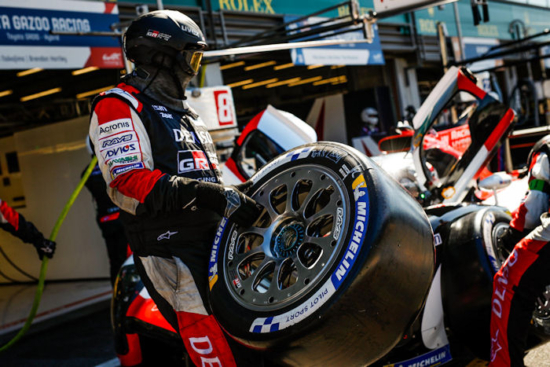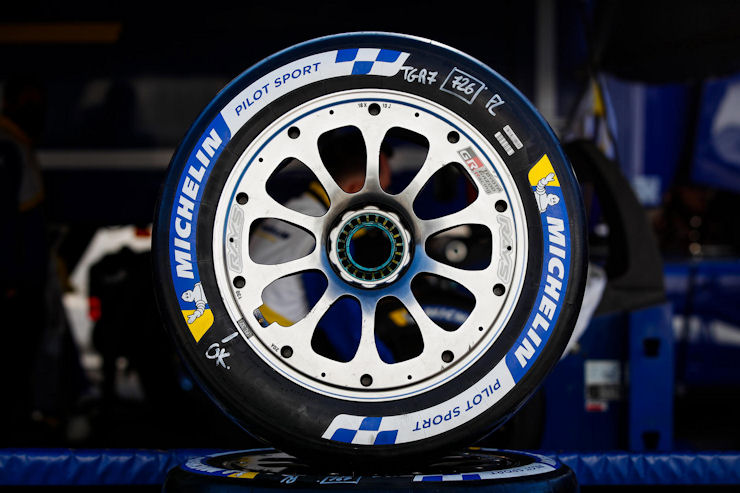WEC: Virtually-developed Michelin Pilot Sport debuting in Le Mans Hypercar
 In addition to slicks, Michelin has developed a new range of wet weather tyres for Hypercar (Photo: Michelin)
In addition to slicks, Michelin has developed a new range of wet weather tyres for Hypercar (Photo: Michelin)
The current season is Michelin’s ninth consecutive year with the FIA World Endurance Championship (FIA WEC), and it has developed a new range of tyres for the headlining Le Mans Hypercar class which replaces LMP1 as the premier class in 2021. All five cars competing in Le Mans Hypercar this year race on Michelin Pilot Sport tyres that were developed almost entirely created using virtual tools.
“The development of these new tyres was something of a challenge for us,” shares Pierre Alves, manager of Michelin’s FIA WEC programme. “We had to work quickly and closely with the constructors, but without access to an actual car. All we could use was simulation software.”
Alves points out that Hypercars are “technically very different” to the LMP1 cars that Michelin worked with in recent years: They are heavier and less powerful, with higher output from their internal combustion engines and less electric power in the case of hybrid cars. Despite weighing more, the Hypercars have the same top speed as their predecessors.
The cars’ aerodynamics are also less complex, with only a single configuration authorised for the entire season compared with two previously. “The teams have consequently had to find a compromise that generates little downforce at fast circuits and less downforce at the slower venues. At the end of the day, these cars put more constraints on their tyres and the phenomenon of wear is more marked. All of these constraints needed to be taken on board, but we have them all covered.”
Excellent results, and fast
Michelin reports that its engineers’ digital- and simulator-based development work “quickly produced excellent results.” The tyres were signed off following their first track tests with Michelin’s partner teams. The partners then organised a number of full-scale tests.
The new Le Mans Hypercar receives the first Michelin range designed exclusively using a simulator, without either an actual or digital car. The tyre maker stresses that thanks to the “might” of its development and simulation systems as well as the experience of its engineers, design work “progressed quickly and in the right direction from the outset.” It further notes that this feat was “all the more remarkable” given that the sizes of the Le Mans Hypercar tyres are new: “Michelin therefore switched from an iterative process founded on experience, simulators, machines and track testing to an all-virtual approach.”
Calling itself a “pioneer” in the field of all-virtual tyre development, Michelin says it is “working on the means” to extend its practice beyond the world of motorsport and into road tyre production.
The tyres for the new Le Mans Hypercar is the first range that Michelin has designed exclusively using a simulator (Photo: Michelin)
Best combination of safety & performance
Le Mans Hypercar teams can choose between soft, medium and hard Michelin slicks, just as the LMP1 runners did last season. In addition, Michelin has developed a new range of wet weather tyres featuring revised compounds. The former Michelin ‘Hybrid’ wet weather tyre is not on offer this year; following regulatory changes, team can instead choose between a new Drying Wet option that covers a broad temperature window in damp or drying conditions and a Full Wet for heavier rain or standing water.
Of the cars racing in the Le Mans Hypercar class, only the Toyota GR010 Hybrid is fitted with 31/71-18 tyres front and rear. The other contenders in the category have opted for what is a new combination for endurance racing: 29/71-18 at the front and 34/71-18 at the rear. Michelin points out that this distinction is due to the different front/rear weight splits of the different prototypes and the fact that only the Toyota GR010 Hybrid runs an electrified system in addition to its internal combustion engine.
“For the Le Mans Hypercar class’s inaugural season, we have sought to obtain the best possible combination of safety and performance for each type of car,” says Alves. “Our work will continue as we collect further data during the year, however. We will then be able to adjust the direction of our development work with a view to introducing key technological innovations as soon as possible. For us, the Le Mans Hypercar class is a big step and the beginning of a development programme that will span several years. Although we are the only tyre manufacturer involved in the category, we will adjust our range in 2022 to meet our partners’ needs even more closely and feed our Research and Development department as part of the process of developing new technologies for production tyres.”
No changes for Le Mans GTE Pro & Le Mans GTE Am
For the Le Mans GTE Pro and Le Mans GTE Am classes, the pandemic situation and a desire to curb costs have led to regulations that specify the use of the same tyres as last year, a move that was not Michelin’s choice.





Comments